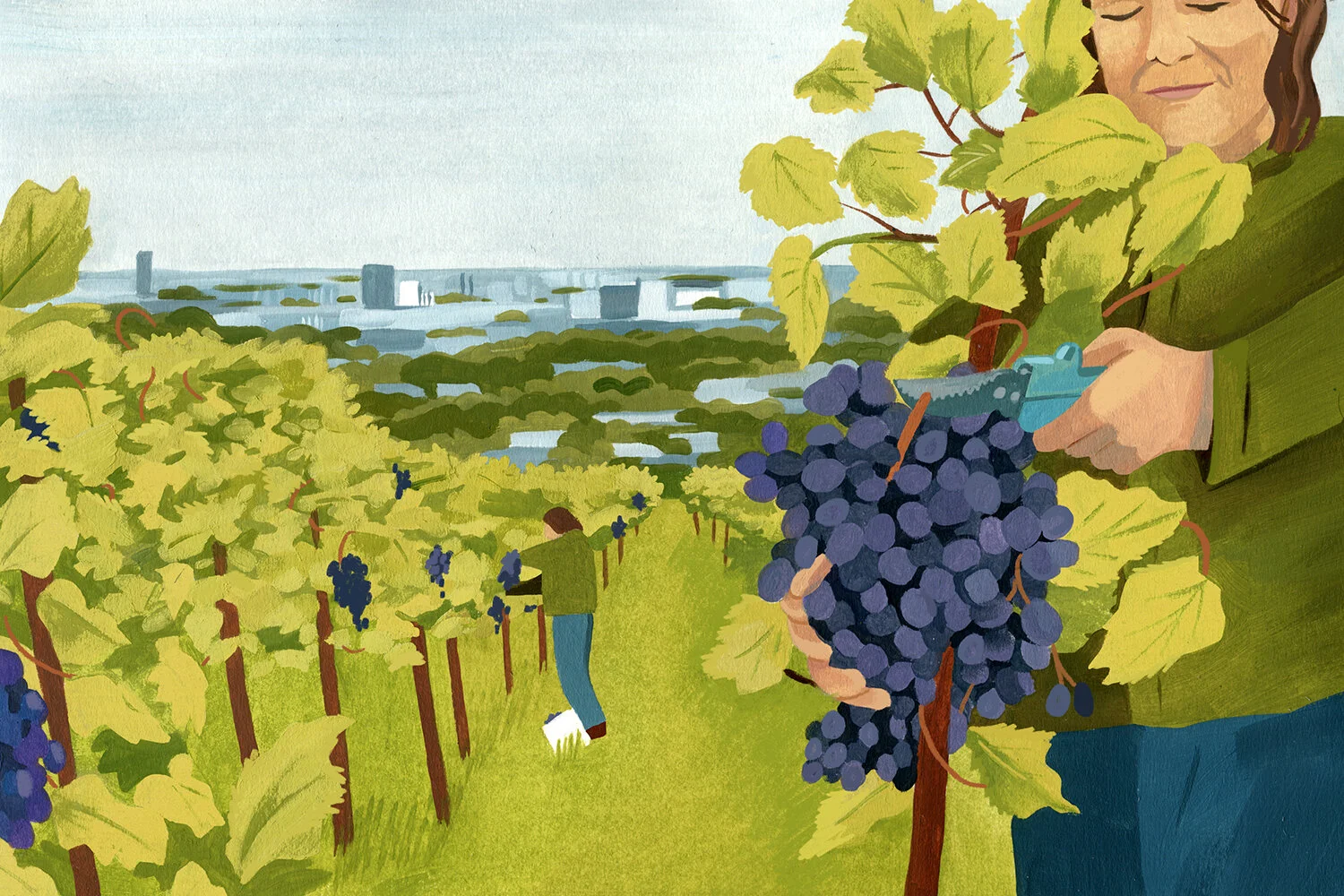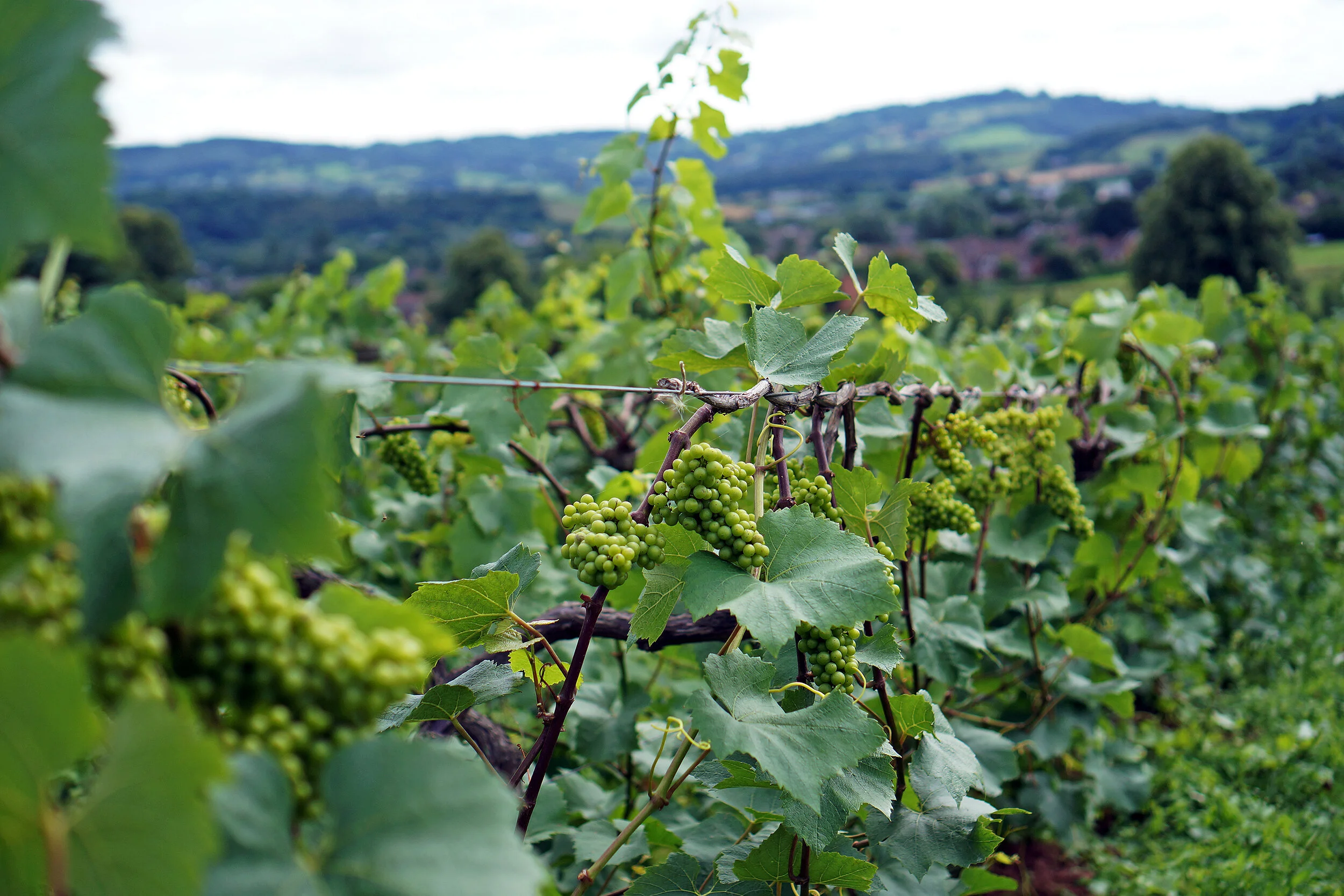Hot, Hot Summer — Was England's 2018 Wine Harvest Really the Best Ever?
I’m standing in the middle of a field in West Sussex, and although it’s late-May, my jumper is knotted around my shoulders as insurance against the freezing cold. Rows of vines shimmer either side of me, their strong stems resiliently upright on the gradient. Sam Linter, head winemaker at Bolney Wine Estate, excitedly flings one arm towards the top of the field. There, a team of workers are piecing together a leaf-green-coloured processing plant to cope with the onslaught of grapes expected in the 2019 season, slated to be almost as good as the “vintage of the century” that rewarded wine growers in 2018.
Thanks to this bumper crop, English wine is being spoken about with more fanfare than ever before. English sparkling wine, particularly from vineyards based in Sussex and Kent, is now widely recognised to be on par with Champagne. This perhaps explains why in 2017 the Champagne house Taittinger planted vines in Kent (though, due to its appellation, they cannot call what they make here Champagne) in order to exploit similar growing conditions as the prestigious house enjoys in France.
Photography by Matthew Curtis
Despite English wine being on an upward trajectory, no one was to predict quite how plentiful the 2018 harvest would be for England’s winemakers. The harvest made headlines and was hailed as the dawn of a new age of English winemaking. The record warm and dry summer produced an intensity and consistency of heat which produced exceptionally ripe grapes. These conditions also produced an increased yield, opening doors for English winegrowers to be more experimental with their surplus and begin to produce more still wine as a whole, and specifically, more English red wine.
Last year, winemakers across the country were picking more grapes than they could press. So much so, Bolney Wine Estate—one of the largest producers of English still wine—aren’t the only vineyard hastily installing new production spaces to cope with the rise in quantity. Many other winemakers are expanding their cellars in an attempt to shake the nightmarish image of vines left with grapes unpicked due to the unmanageable yield, which was sadly the reality for many in 2018.
But other than the obvious opportunity for sales growth and expansion for the industry, what else can we take forward from the 2018 harvest? Was it really the best the country’s ever seen?
“Over the last 46 years here at Bolney this is certainly one of the best harvests we have experienced,” Sam says. “Throughout the whole season, every critical area had near perfect conditions: no real frost issues around bud burst, no rain at flowering, fruit with warm and very dry conditions, lots of heat and sunshine throughout the ripening month, and finally, warm nights.”
I'm sitting on the terrace of the restaurant at Bolney Wine Estate with senior production manager, Alex Rabagliati, drinking a glass of their Lychgate Bacchus from 2018. It’s crisp and complex, offering distinctive notes of grapefruit and elderflower.
“The 2018 harvest produced perfect physiological ripeness, as well as large yields,” Alex tells me. In other words, the harvest produced quality as well as quantity. “The physiology is measured differently on a grape-by-grape basis—the sugar levels of the Chardonnay, for instance, and the deep colour of the Pinot Gris, were clear signifiers of quality.”
“Broadly I would say the 2018 harvest produced wines with great body and really ripe fruit [characteristics],” Alex says. He’s quick to acknowledge the consistent level of acidity in the fruit throughout production as another key signifier of quality. “Particularly in the still whites,” he says. “A good acid line helps the wine develop further flavours while ageing in the bottle.”
Once these wines have developed in bottle, having aged a year or two longer, there’ll be a stronger understanding of the legacy of 2018’s harvest. “2018 wines are only starting to be released,” Warwick Smith, founder of London-based “urban winery” Renegade reminded me during a recent conversation. “Remember it's only been eight months since the grapes were picked off the vines.”
***
While we wait impatiently for the ageing process to reveal the full value of the 2018 harvest, inside the industry, those winemakers wanting to experiment in still wine production have reason to be excited. Sparkling wine can be made with grapes with a higher acidity, which are more plentiful, but still wine needs grapes with a perfect ripeness, which are harder to grow in a tumultuous British climate. The surplus of grapes with higher levels of ripeness harvested last year has been brilliant news for estates like Bolney.
“Purchasing more tanks to hold the extra crop was almost impossible, everyone wanted them,” Sam shrugs, thinking back to the challenging end to last summer.
Warwick from Renegade agrees: “Most wineries have filled their boots—or more literally their tanks—to the brim. The great harvest last year will have the biggest impact, in terms of quality, on still whites, skin contact (orange) wines, rosés and reds. These are the ones to really watch out for.”
““Throughout the whole season, every critical area had near perfect conditions”
”
Regardless of what happens with the still wines, London’s best wine bars and award-winning restaurants such as Noble Rot, are racing to serve 2018’s finest English sparkling whites and rosés. “A current staff favourite is the Tillingham PN18 pét-nat rosé,” Joshua Castle, sommelier at Noble Rot tells me. “It’s made from a blend of varietal crossings: Ortega, Müller Thurgau, Dornfelder, Rondo and Pinot Noir.”
“Winemaker Ben Walgate is pushing the envelope with minimal intervention winemaking and organic farming. The PN18 is a nice representation of Walgate's ethos: the wine pours cloudy pink from a starkly designed bottle, with gently sparkling bubbles. There's a bit of a wild edge to the fruit flavours.”
Joshua, who is a wine buyer, not a winemaker, has no particular allegiance to English wine, but holds the Bacchus variety, the fourth most planted grape variety in England, in high regard, for its “impressive array of styles.”
“Some show off the grape's more tropical side, others the more herbaceous and grassy side. The 2018 Baker St Bacchus from London Cru [winery] has an attractive red fruit flavour and is dry and refreshing. While [Kent winery] Chapel Down’s 2018 Sparkling Bacchus carries a little bit of residual sugar, but with a taught and zippy acidity, and 12% ABV is imminently drinkable.”
Joshua’s favourites are consistent with many sommeliers who tend to celebrate English sparkling, but are hesitant about English still wines. Part of the reason that sommeliers are wary, is due to the use of unfamiliar hybrid grape varieties by English winemakers. This can act as a barrier to sale when dealing with your typical consumer.
“Often these varietals are obscure, with names like Ortega, Huxelrebe and Siegerrebe. It's going to be tricky to sell a consumer on ‘a glass of Huxelrebe,” Joshua says.
“I think that there is real potential for the category,” he explains. “But there are a few problems that the industry needs to overcome. Vines are notoriously temperamental, and entire crops can be devastated by frost, hail, excess rain or disease. Being in a cool climate amplifies these risk factors. These hybrid grape varieties are well suited to the cold British climate.”
One method adopted by wine marketers to swerve the awkward-sounding names of hybrid grapes is to market English still whites as “dry whites” or “sweet whites”. One example of a winery using this naming system is Davenport Vineyards of Sussex and Kent, which Joshua says is “not frightening off consumers with unpronounceable grape names.”
““2018 wines are only starting to be released, remember it’s only been eight months since the grapes were picked off the vines.” ”
On the contrary, there is evidence to suggest we British aren’t such a “frightened” bunch—at least not any longer.
“At the moment there is a huge demand for small artisanal producers making interesting wines,” James Harrison, wine manager at Michelin-starred Brat restaurant in Shoreditch, tells me. “There is definitely a movement away from mass-produced wines and big brands, and this is actually being echoed in the restaurant scene at the moment with many large chains being shut down, making room for smaller independent restaurants.”
***
Now that winemakers are more prepared than ever in the event of another mammoth harvest, there’s an increased sense of optimism about the future of English wine—both in terms of expansion and increasing diversity. As Joshua, from Noble Rot puts it: “Well sourced UK produce is undoubtedly some of the best in the world, and I'm sure we'll see more of the UK's top restaurants offering local wines to match.”
Despite the rising popularity of English wine, in my home patch of east London I often struggle to find a bottle of it, even though the area is known for having some of the best restaurants and bars around. While it’s there to be found if you search hard enough, London’s wine bars still seem intent on prioritising wine from abroad.
This is likely due to the current profile of English wine, which still trails behind the profiles of its international competitors. Hopefully the 2018 harvest will offer the English wine industry a dose of much-needed PR support, because I believe it is genuinely every bit as delicious as the imported offerings of our European competitors.
If you’d rather not wait a moment longer to sample last year’s harvest to make up your own mind, plenty of English still wine from 2018 is already bottled. The Lychgate Bacchus and the Pinot Gris, both from Bolney showcase the diversity of the harvest—the latter with a more citrus-forward freshness and a touch more body than the delicate Bacchus.
And, as Bolney’s Sam Linter puts it: “Still wine offers a great opportunity to taste the quality of last year without having to wait three years for the sparkling wine to be ready.”















